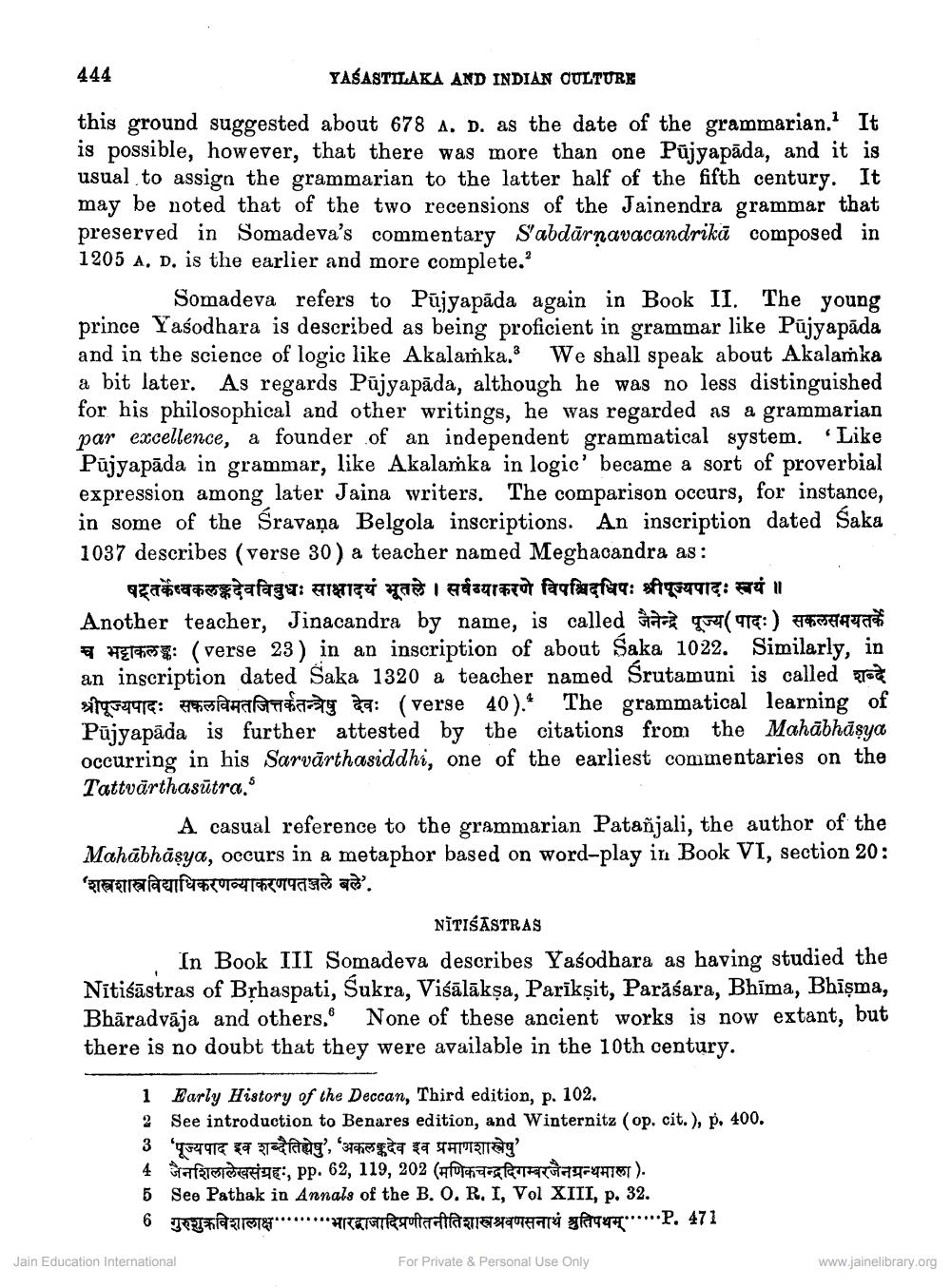________________
444
YASASTILAKA AND INDIAN CULTURE
this ground suggested about 678 A. D. as the date of the grammarian.' It is possible, however, that there was more than one Pujyapāda, and it is usual to assign the grammarian to the latter half of the fifth century. It may be noted that of the two recensions of the Jainendra grammar that preserved in Somadeva's commentary S'abdārṇavacandrikā composed in 1205 A. D. is the earlier and more complete."
Somadeva refers to Pujyapada again in Book II. The young prince Yasodhara is described as being proficient in grammar like Pujyapāda and in the science of logic like Akalamka.3 We shall speak about Akalamka a bit later. As regards Pujyapāda, although he was no less distinguished for his philosophical and other writings, he was regarded as a grammarian par excellence, a founder of an independent grammatical system. 'Like Pujyapāda in grammar, like Akalamka in logic' became a sort of proverbial expression among later Jaina writers. The comparison occurs, for instance, in some of the Śravana Belgola inscriptions. An inscription dated Śaka 1037 describes (verse 30) a teacher named Meghacandra as:
षट्तर्केण्वक लङ्कदेव विबुधः साक्षादयं भूतले । सर्वव्याकरणे विपश्चिदधिपः श्रीपूज्यपादः स्वयं ॥ Another teacher, Jinacandra by name, is called जैनेन्द्रे पूज्य ( पादः ) सकलसमयतर्के (verse 23) in an inscription of about Saka 1022. Similarly, in an inscription dated Saka 1320 a teacher named Śrutamuni is called श्रीपूज्यपादः सकलविमत जित्तर्कतन्त्रेषु देवः ( verse 40 ) . 4 The grammatical learning of Pujyapada is further attested by the citations from the Mahabhāṣya occurring in his Sarvarthasiddhi, one of the earliest commentaries on the Tattvärthasutra.s
A casual reference to the grammarian Patañjali, the author of the Mahābhāṣya, occurs in a metaphor based on word-play in Book VI, section 20: 'शस्त्रशास्त्र विद्याधिकरणव्याकरणपतञ्जले बले'.
NĪTISASTRAS
In Book III Somadeva describes Yasodhara as having studied the Nitisastras of Brhaspati, Sukra, Visālākṣa, Parīkṣit, Parāśara, Bhima, Bhisma, Bharadvaja and others, None of these ancient works is now extant, but there is no doubt that they were available in the 10th century.
1 Early History of the Deccan, Third edition, p. 102.
2
See introduction to Benares edition, and Winternitz (op. cit.), p. 400.
3 'पूज्यपाद इव शब्दैतिह्येषु', 'अकलङ्कदेव इव प्रमाणशास्त्रेषु'
4 जैनशिलालेखसंग्रहः, pp. 62, 119, 202 (मणिकचन्द्रदिगम्बर जैन ग्रन्थमाला ).
5 See Pathak in Annals of the B. O. R. I, Vol XIII, p. 32.
6 गुरुशुक्रविशालाक्ष"
Jain Education International
'भारद्वाजादिप्रणीत नीतिशास्त्रश्रवणसनाथं श्रुतिपथम् P. 471
For Private & Personal Use Only
www.jainelibrary.org




